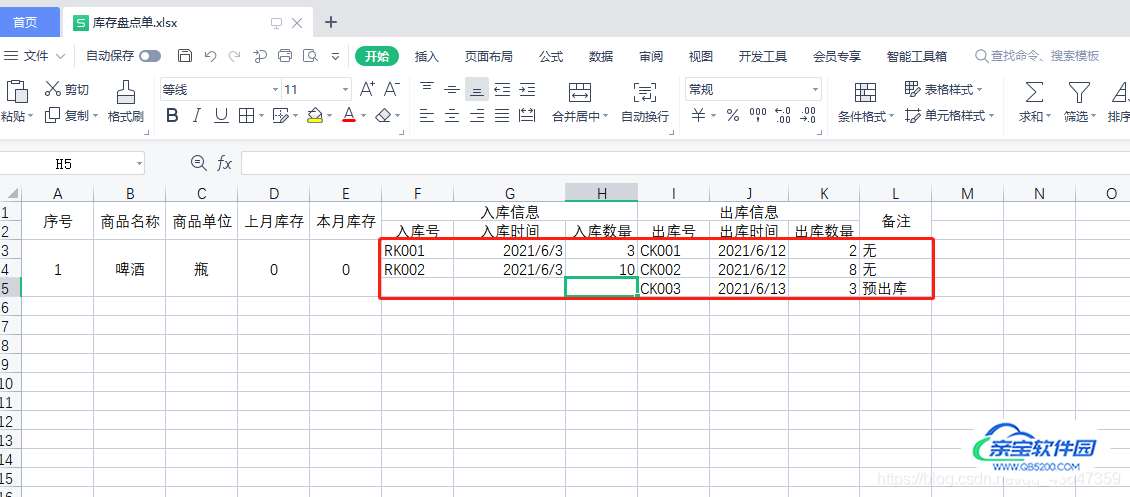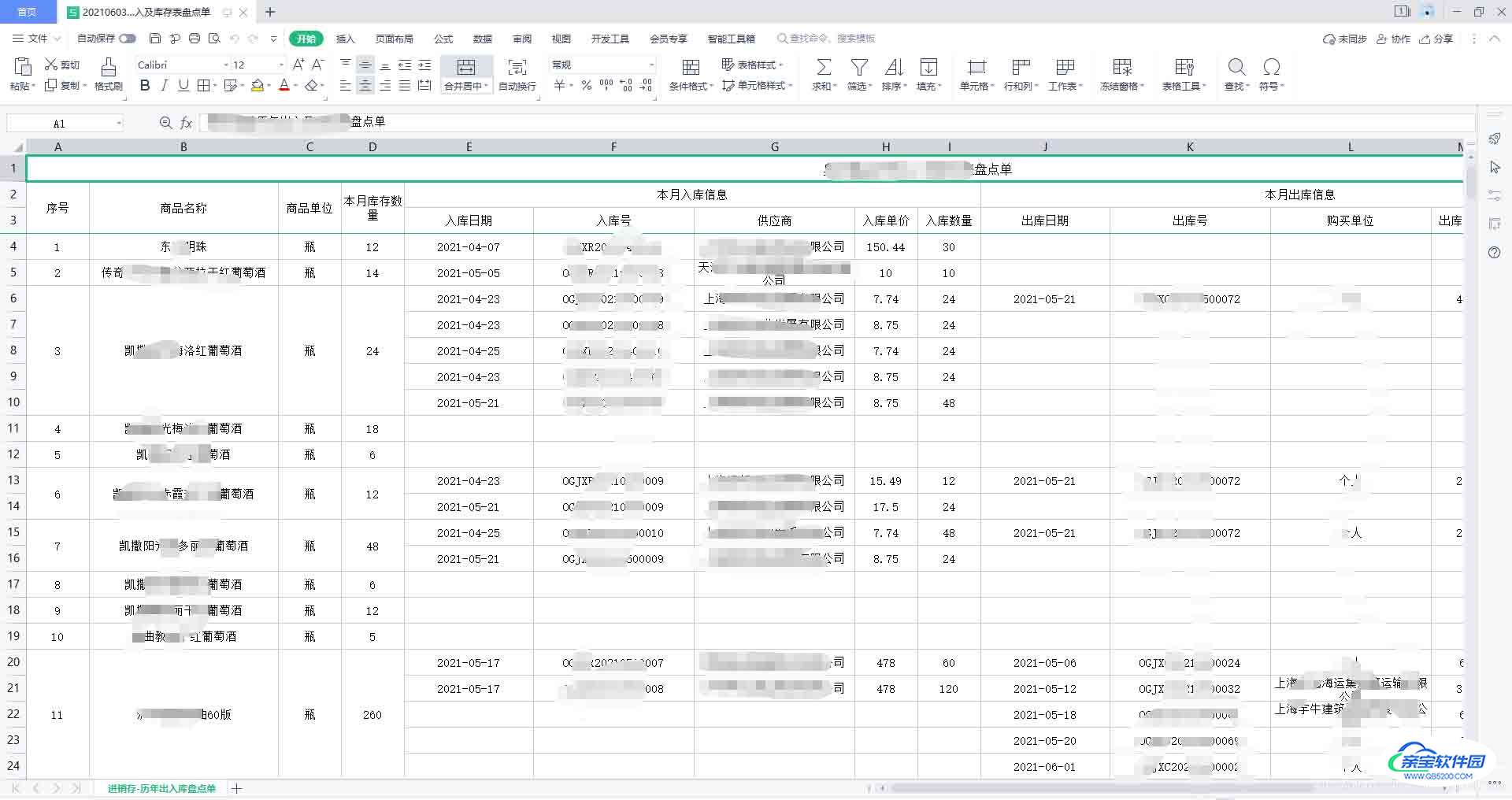使用EasyPoi完成复杂一对多excel表格导出功能全过程
南独酌酒nvn 人气:0业务需求
从一个简单的仓库业务说起,仓库业务,会有进库记录,会有出库记录,会有库存,客户的需求就是需要一个库存盘点单,盘点单通俗来讲:将库存中每个商品的出入库记录都统计出来,看看每个商品出过多少货物,入过多少货物,本月库存多少,上月库存多少。
需求难点
一个货物会出过多次货物,入过多次货物,导出的 excel 就要做成 一对多 格式的导出
简单举例:
啤酒:入库2次,出库3次,最终体现在 excel 中效果如下图:

通过 EasyPoi 实现需求
EasyPoi 文档地址:http://doc.wupaas.com/docs/easypoi/easypoi-1c0u4mo8p4ro8
SpringBoot 使用:
<dependency>
<groupId>cn.afterturn</groupId>
<artifactId>easypoi-base</artifactId>
<version>4.2.0</version>
</dependency>
<dependency>
<groupId>cn.afterturn</groupId>
<artifactId>easypoi-annotation</artifactId>
<version>4.2.0</version>
</dependency>
<dependency>
<groupId>cn.afterturn</groupId>
<artifactId>easypoi-web</artifactId>
<version>4.2.0</version>
</dependency>
Gradle 使用:
implementation 'cn.afterturn:easypoi-base:4.2.0' implementation 'cn.afterturn:easypoi-annotation:4.2.0' implementation 'cn.afterturn:easypoi-web:4.2.0'
使用 EasyPoi 提供的注解,自定义导出类模板
import cn.afterturn.easypoi.excel.annotation.Excel;
import cn.afterturn.easypoi.excel.annotation.ExcelCollection;
import cn.afterturn.easypoi.excel.annotation.ExcelIgnore;
import lombok.Getter;
import lombok.Setter;
import java.io.Serializable;
import java.math.BigDecimal;
import java.util.Date;
import java.util.List;
/**
* 导出 excel 模板类
*/
@Getter
@Setter
public class ExportTemplate implements Serializable {
@Excel(name = "序号", needMerge = true, type = 10)
private int index;
@Excel(name = "商品名称", needMerge = true, width = 30.0)
private String goodName;
@Excel(name = "商品单位", needMerge = true)
private String goodUnit;
@Excel(name = "上月库存数量", needMerge = true, type = 10)
private Integer lastMonthSurplusNum;
@Excel(name = "本月库存数量", needMerge = true, type = 10)
private Integer thisMonthSurplusNum;
@ExcelCollection(name = "本月入库信息")
private List<GoodInItem> goodInItems;
@ExcelCollection(name = "本月出库信息")
private List<GoodOutItem> goodOutItems;
@Excel(name = "备注", needMerge = true, width = 30.0)
private String remark;
/**
* 入库信息
*/
@Getter
@Setter
public static class GoodInItem {
@Excel(name = "入库日期", exportFormat = "yyyy-MM-dd", width = 20.50)
private Date purchaseDate;
@Excel(name = "入库号", width = 25.50)
private String purchaseNum;
@Excel(name = "入库单价", type = 10)
private BigDecimal unitPrice;
@Excel(name = "入库数量", type = 10)
private Integer totalNum;
}
/**
* 出库信息
*/
@Getter
@Setter
public static class GoodOutItem {
@Excel(name = "出库日期", exportFormat = "yyyy-MM-dd", width = 20.50)
private Date outDate;
@Excel(name = "出库号", width = 25.50)
private String sellNum;
@Excel(name = "出库数量", type = 10)
private Integer totalNum;
@Excel(name = "成本金额", type = 10)
private BigDecimal priceIn;
@Excel(name = "销售金额", type = 10)
private BigDecimal priceOut;
}
}
实体类中使用的注解作用解释:
- 1.@Getter lombok 注解,用于给所有属性提供 getter 方法
- 2.@Setter lombok 注解,用于给所有属性提供 setter 方法
- 3.@Excel easypoi 注解,name 就等于导出 excel 的列名称,width 就是宽度,type 就是这个属性的类型,1表示文本,默认也是文本,10就是数字,needMerge 表示是否纵向合并单元格,也就是上下列合并
- 4.@ExcelCollection easypoi 注解,name 就等于导出 excel 的列名称,被此注解标注的集合,就等于在其列下面创建对等数量的行,就类似于这种

最后模板弄好之后,就可以通过easypoi 的工具类来导出,easypoi 推荐的导出工具类如下:

这个方法的三个参数表示含义解释:
ExportParams:参数表示Excel 导出参数设置类,easypoi 自定义的类pojoClass:你要导出的类模板dataSet:数据集合
具体实现
@GetMapping(value = "export")
public void export(HttpServletRequest req, HttpServletResponse resp) {
List<ExportTemplate> exportData = new ArrayList();
// 步骤1:构建要导出excel的数据集合
for (int i = 0; i < 5; i++) {
ExportTemplate data = new ExportTemplate();
data.setIndex(i);
data.setGoodName("测试商品");
data.setGoodUnit("瓶");
data.setLastMonthSurplusNum(5); // 上月库存
data.setThisMonthSurplusNum(3); // 本月库存
// ... 剩下的就是类似的加值
exportData.add(data);
}
try {
// 步骤2:开始导出 excel
ExportParams params = new ExportParams();
params.setTitle("库存盘点单标题");
params.setSheetName("库存盘点单工作表名称");
params.setType(ExcelType.XSSF);
Workbook workbook = ExcelExportUtil.exportExcel(params, ExportTemplate.class, exportData);
String nowStr = DateTimeFormatter.ofPattern(LocalDateTime.now()).format("yyyyMMddHHmm"); // 时间串
String fileName = nowStr + "_库存盘点单"; // 文件名称
String tempDir = "C:/Users/huxim/Downloads";
File filePath = new File(tempDir + File.separator);
if (!filePath.exists()) filePath.mkdirs(); // 如果文件目录不存在就创建这个目录
FileOutputStream fos = new FileOutputStream(tempDir + File.separator + fileName);
workbook.write(fos);
fos.close();
resp.setContentType("application/octet-stream");
resp.setCharacterEncoding("utf-8");
response.addHeader("Content-disposition", "attachment; filename="
+ this.makeDownloadFileName(req, fileName));
IOUtils.copy(new FileInputStream(tempFile), response.getOutputStream());
System.out.println("导出成功~~~");
} catch (Exception e) {
throw new RuntimeException("导出 excel 失败~~~");
}
}
/**
* 判断是否是 IE 浏览器
* 返回对应的字符串格式
*/
public static String makeDownloadFileName(HttpServletRequest request, String fileName) {
String agent = request.getHeader("User-Agent");
byte[] bytes = fileName.getBytes(StandardCharsets.UTF_8);
if (agent.contains("MSIE") || agent.contains("Trident") || agent.contains("Edge")) {
// IE
return new String(bytes, StandardCharsets.UTF_8);
} else {
return new String(bytes, StandardCharsets.ISO_8859_1);
}
}
导出成功后的excel 就类似于如下这种:

总结
以上为个人经验,希望能给大家一个参考,也希望大家多多支持。
加载全部内容